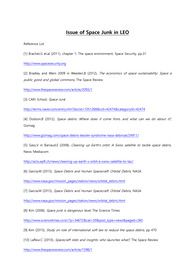

-
미리보기
소개
본 Essay는 영국 유학시절 원어민 교수님께 첨삭을 받은 Essay 입니다.
영국식 영어로 작성된 글입니다.
19개의 Reference를 통해 작성되었습니다.목차
없음본문내용
Since the first artificial satellite called Sputnik 1 was launched by the Soviet Union in 1957, many countries have launched projectiles in space to gain many kinds of information and demonstrate developed technologies. According to Kim (2015), the number of projectiles launched by countries is approximately 3,000. But the total number is more than 6,600 when the number of informal spy and military satellites is included. This lead to a lot of space junk which is defined that it is debris after rockets are separated from a satellite, a space shuttle and a missile and the old satellites which cannot operate are also artificial space debris. This essay will describe two main causes of the increase in space junk in earth orbit in terms of the space race and the Kessler Syndrome as well as the effects on humans and present circumstances to overcome it.
The growing amount of space junk becomes a serious issue.참고자료
· Brachet.G et.al (2011), chapter 1: The space environment, Space Security, pp.31
· http://www.spacesecurity.org
· Bradley and Wein 2009 in Weeden.B (2012), The economics of space sustainability: Space a public good and global commons, The Space Review
· http://www.thespacereview.com/article/2093/1
· CARI School, Space Junk
· http://terms.naver.com/entry.nhn?docId=1051268&cid=42474&categoryId=42474
· Dodson.B (2012), Space debris: Where does it come from, and what can we do about it?, Gizmag
· http://www.gizmag.com/space-debris-kessler-syndrome-nasa-debrisat/24911/
· Gass.V in Barraud.E (2008), Cleaning up Earth’s orbit: A Swiss satellite to tackle space debris, News Mediacom
· http://actu.epfl.ch/news/cleaning-up-earth-s-orbit-a-swiss-satellite-to-tac/
· Garcia.M (2015), Space Debris and Human Spacecraft: Orbital Debris, NASA
· http://www.nasa.gov/mission_pages/station/news/orbital_debris.html
· Garcia.M (2015), Space Debris and Human Spacecraft: Orbital Debris, NASA
· http://www.nasa.gov/mission_pages/station/news/orbital_debris.html
· Kim (2006), Space junk is dangerous level, The Science Times
· http://www.sciencetimes.co.kr/?p=34672&cat=30&post_type=news&paged=260
· Kim (2015), Study on role of international soft law to reduce the space debris, pp 470
· Lafleur.C (2010), Spacecraft stats and insights: who launches what?, The Space Review
· http://www.thespacereview.com/article/1598/1
· Lewis.H (2015), Trouble in orbit: the growing problem of space junk, Space junk in numbers, BBC
· http://www.bbc.co.uk/news/science-environment-33782943
· NASA, Three Classes of Orbit: High Earth Orbit, Medium Earth Orbit, Low Earth Orbit, NASA EARTH OBSERVATORY
· http://earthobservatory.nasa.gov/Features/OrbitsCatalog/page2.php
· Park,L, When Satellites Fall: On the Trails of Cosmos 954 and USA 193: Cosmos 954
· http://www.flowjournal.org/2009/06/when-satellites-fall-on-the-trails-of-cosmos-954-and-usa-193lisa-parks-uc-santa-barbara/
· Plumer.B (2013), Space trash is a big problem. These economists have a solution: The space-trash dilemma, The Washington Post
· https://www.washingtonpost.com/news/wonk/wp/2013/10/24/space-is-filling-up-with-garbage-heres-why-we-should-tax-it/
· Tate.K (2013), Space Junk Explained: How Orbital Debris Threatens Future of Spaceflight (Inforgraghic), SPACE.COM
· http://www.space.com/23039-space-junk-explained-orbital-debris-infographic.html
· UNITED NATIONS Office for Outer Space Affairs, TREATIES in Space Law Treaties and Principles
· http://www.unoosa.org/oosa/en/ourwork/spacelaw/treaties.html
· Weeden.B (2012), The economics of space sustainability: Lack of private actors deriving private benefits, The Space Review
· http://www.thespacereview.com/article/2093/1
· Weinberger.S (2012), Space Junk: Why it is time to clean up the skies: Junk collector, BBC
· http://www.bbc.com/future/story/20120518-danger-space-junk-alert
· Weinberger.S (2012), Space Junk: Why it is time to clean up the skies: Snowball effect, BBC
· http://www.bbc.com/future/story/20120518-danger-space-junk-alert태그
-
자료후기
-
자주묻는질문의 답변을 확인해 주세요

꼭 알아주세요
-
자료의 정보 및 내용의 진실성에 대하여 해피캠퍼스는 보증하지 않으며, 해당 정보 및 게시물 저작권과 기타 법적 책임은 자료 등록자에게 있습니다.
자료 및 게시물 내용의 불법적 이용, 무단 전재∙배포는 금지되어 있습니다.
저작권침해, 명예훼손 등 분쟁 요소 발견 시 고객센터의 저작권침해 신고센터를 이용해 주시기 바랍니다. -
해피캠퍼스는 구매자와 판매자 모두가 만족하는 서비스가 되도록 노력하고 있으며, 아래의 4가지 자료환불 조건을 꼭 확인해주시기 바랍니다.
파일오류 중복자료 저작권 없음 설명과 실제 내용 불일치 파일의 다운로드가 제대로 되지 않거나 파일형식에 맞는 프로그램으로 정상 작동하지 않는 경우 다른 자료와 70% 이상 내용이 일치하는 경우 (중복임을 확인할 수 있는 근거 필요함) 인터넷의 다른 사이트, 연구기관, 학교, 서적 등의 자료를 도용한 경우 자료의 설명과 실제 자료의 내용이 일치하지 않는 경우
문서 초안을 생성해주는 EasyAI


